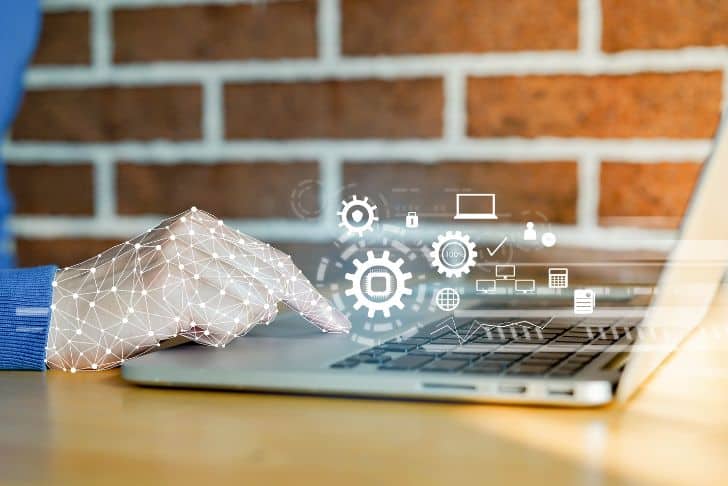“Integrating AI and Robotic Process Automation in Digital Process Automation for Enhanced Customer Experience” intricately explores the transformative power of Digital Process Automation (DPA). DPA, an evolution of Business Process Management (BPM), harnesses the collective strength of people, applications, devices, and information, for a hospitable digital climate. This new breed of automation extends its reach further than BPM, empowering your entire organization to build smart, process-digitizing applications. Employing robust analytics, artificial intelligence, machine learning, and other advanced technologies, DPA revolutionizes customer experiences and encourages digital transformation. Low-code development, a focus on consumer-grade user experiences, and AI-based innovation are essential features of DPA that usher in this change.
With the integration of artificial intelligence and robotic process automation, DPA paves the way for “intelligent process automation,” that fosters enhanced, intuitive customer experiences, organization-wide collaboration, cost reduction, and enriched innovation, thus adding a layer of agility to legacy systems and accomplishing digital metamorphosis.

Understanding Digital Process Automation
In a society increasingly geared towards digital environments, understanding Digital Process Automation (DPA) is essential. DPA is a mechanism that brings together people, applications, devices, and information across an organization to create an agile digital environment. As we delve deeper into this topic, you’ll gain a better grasp of what DPA means and the prominent role it plays within organizations.
Definition of Digital Process Automation
Digital Process Automation (DPA) refers to the use of digital technology to perform a process in order to accomplish a workflow or function. DPA’s primary goal is to automate, optimize, and improve on pre-existing manual processes, which goes a long way in saving time, reducing errors, and improving overall productivity.
Evolution from Business Process Management to Digital Process Automation
DPA has evolved from Business Process Management (BPM), with its focus shifting towards improving and digitizing processes. Although BPM was integral in optimizing back office tasks to reduce costs, DPA strives to deliver more by impacting the enhancement of customer experiences, driving digital transformation, and inspiring innovation.
Pivotal role of Digital Process Automation in organizations
Organizations use DPA to better manage, automate and optimize their processes, the result being improved productivity, increased efficiency, and decreased operational costs. Moreover, DPA plays a vital role in enhancing customer experiences and driving an organization’s digital transformation, thereby fostering a more agile and robust digital environment.
Features of Digital Process Automation
There are three defining features of DPA which set it apart: low-code development platforms, emphasis on consumer-grade user experiences, and the incorporation of artificial intelligence.
Low-code development platforms
DPA uses low-code platforms which empower business users to automate processes integral to both customer experience and digital transformation. With this feature, even those without extensive technical know-how can create and deploy applications, accelerating digital workflow and reducing the need for intervention from IT experts.
Emphasis on consumer-grade user experiences
DPA’s emphasis on consumer-grade user experiences is another noteworthy feature. Through DPA, organizations can create powerful, consumer-grade digital experiences for customers across various channels, which enhances user engagement and overall user satisfaction.
Incorporation of Artificial Intelligence
Among DPA’s distinctive features is its incorporation of artificial intelligence (AI). AI, when coupled with DPA, can lead to intelligent process automation, which brings about improved efficiency and greater accuracy in digital operations.
Incorporating AI and RPA in Digital Process Automation
AI and RPA are two key technologies that greatly enhance DPA when integrated. Let’s explore these in finer detail.
What is Robotic Process Automation
Robotic Process Automation (RPA) is a technology that employs software robots or ‘bots’ to automate human tasks that are rule-based, repetitive, and prone to errors.
What is Artificial Intelligence
Artificial Intelligence, on the other hand, refers to the device’s capability to mimic human intelligence and perform tasks that normally require human intellect such as problem-solving, learning, planning, and understanding complex ideas.
How AI and RPA enhance Digital Process Automation
Both AI and RPA, when incorporated into DPA, significantly boost its effectiveness. AI provides the ability to analyze complex data and draw meaningful information, while RPA allows mundane, rule-based tasks to be automated. This frees up humans to focus on more creative, value-adding tasks, increases task accuracy, reduces the time taken to perform tasks, and fundamentally transforms the workflow.
Achieving Intelligent Process Automation
Intelligent Process Automation (IPA) is achieved when DPA is enhanced with AI and RPA.
Definition and Overview of Intelligent Process Automation
IPA mechanizes not only physical tasks but cognitive tasks as well. While physical tasks involve activities like data entry, cognitive tasks involve decision making, data analyses, and dealing with exceptions in business rules.
Connection between Intelligent Process Automation and DPA
Integrating AI and RPA with DPA leads to IPA, which combines the analytical capabilities of AI with the automation capabilities of RPA, to improve process efficiency and accuracy.
Benefits of integrating AI and RPA into DPA
By integrating AI and RPA into DPA, organizations can achieve greater workflow efficiency, reduce operational costs, minimize errors, and improve customer service. IPA frees up employees’ time and allows them to contribute at a higher level in the organization.

Enhancing Customer Experience with DPA
Enhancing the customer experience is one of the key goals of DPA, as it plays a pivotal role in determining an organization’s success.
Role of DPA in Customer Experience
DPA enables businesses to automate customer-centric processes, thereby providing consumers with seamless and personalized experiences. This results in improved customer satisfaction, as well as productivity and efficiency in business functions.
How Intelligent Process Automation improves Customer Experience
IPA adds another layer of sophistication to the customer experience. With its ability to analyze large amounts of data, it can provide more personalized and informed interaction to customers. IPA can also predict customer behavior based on past interactions, allowing organizations to proactively meet customer needs and expectations.
Examples of improved Customer Experience through DPA
Take for instance, the banking industry. Banks utilize DPA to automate processes such as client onboarding, loan origination, and fraud detection. This increases speed, reduces errors, allowing banks to serve customers better and faster. Additionally, customer queries can be resolved much quicker with automated response systems, greatly enhancing customer satisfaction.
Driving Digital Transformation with DPA
Digital transformation is at the top of many organizations’ agendas today, and DPA is at the forefront of this movement, facilitating smoother and more efficient digital transitions.
What is Digital Transformation
Digital transformation refers to the process of employing digital technologies to create new or modify existing business processes, culture, and customer experiences, thereby meeting changing business and market requirements.
Importance of Digital Transformation
Digital transformation is vital for organizations wanting to stay competitive in today’s market. It allows businesses to be more efficient, data-driven, and customer-centric, effectively leading to improved service delivery, and ultimately, higher profitability.
How DPA facilitates Digital Transformation
DPA assists businesses in their digital transformation by allowing them to streamline and automate their processes. It reduces the dependency on manual and paper-based processes; makes data more accessible, leading to better decision-making; and improves service delivery. By implementing DPA, organizations can quickly adapt to changing market trends and customer demands.

Reducing Operational Costs through DPA
DPA also plays a significant role in reducing operational costs within organizations.
Connection between DPA and Operational Costs
By automating processes and removing manual interventions, DPA effectively reduces the time spent on completing tasks, reduces the likelihood of errors, and improves productivity. This ultimately leads to significant cost savings.
Examples of cost reduction through DPA
Consider the case of a little-known manufacturing firm. By automating its procurement process through DPA, the company saved a significant amount of time in paperwork, reduced human errors, and shortened its procurement cycle. The firm was able to save costs, increase productivity, and focus on core business functions.
Long-term financial benefits of DPA
Apart from immediate cost savings, DPA also offers long-term financial benefits. These include future cost savings from improved efficiency and productivity, lower training costs due to intuitive interfaces, and revenue growth from enhanced customer satisfaction.
Freeing Employees for Innovation with DPA
A key advantage of DPA is it can free up employees from mundane tasks, allowing them to focus on more innovative, value-adding roles.
DPA and mundane tasks
Implementing DPA means letting go of mundane, repetitive tasks that have long been a part of employees’ job descriptions. These tasks can now be automated, allowing employees more time to focus on the strategic aspects of their roles.
How DPA fosters innovation
By automating routine tasks, DPA provides employees with the time and freedom to focus on innovation. They can better understand customer needs, come up with creative solutions, and contribute to the strategic goals of the organization.
Impact of DPA on productivity and employee engagement
Innovation fosters greater productivity and improves employee engagement. When employees are not tied down by routine tasks and have the freedom to use their skills in more meaningful ways, they are likely to be more engaged and motivated in their work.
Adding Agility to Legacy Systems with DPA
Legacy systems, while stable and reliable, often lack the flexibility and scalability provided by modern technologies. DPA can help overcome these challenges.
Challenges of Legacy Systems
Legacy systems often fall short in terms of meeting modern business needs. They are difficult to integrate with modern applications, lack flexibility and scalability and can be expensive to maintain.
How DPA adds agility to Legacy Systems
DPA can add vastly needed agility to legacy systems. By automating and digitizing processes, DPA can enhance the usability of legacy systems. Making them more adaptable to the needs of the modern business environment.
Benefits of integrating DPA with Legacy Systems
Integrating DPA with legacy systems can increase the latter’s functionality, extend their lifespan, and enhance their return on investment. This is achieved not by replacing them entirely but by making them more capable of dealing with modern demands.
Building an Agile and Digital Environment with DPA
An agile digital environment is the ultimate goal of most businesses today, and DPA plays an essential part in achieving this.
Goals of an Agile and Digital Environment
The main aim of achieving an agile digital environment is to be more responsive to market changes, improve customer satisfaction, increase the speed of innovation, and maintain a competitive advantage.
Role of DPA in achieving these goals
DPA, with its features such as low-code development, AI incorporation, and consumer-grade interfaces, plays a vital role in achieving these goals. By improving and automating processes, DPA paves the way for a more agile, efficient, and responsive business capability.
Case studies of successful implementation of DPA
One global retailer, for instance, used DPA to automate its inventory management, supply chain processes, and customer service. This led to improved customer satisfaction, reduced operational costs and increased agility in adapting to changing market trends.
To sum up, DPA represents a valuable tool that organizations can leverage in shaping their digital futures. Through its many features and benefits, DPA can bring about improved customer experiences, drive digital transformation, reduce operational costs, and enhance the culture of innovation.
